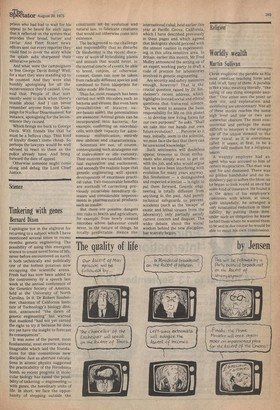Science
Tinkering with genes
Bernard Dixon
I apologise not in the slightest for returning to a subject which I have mentioned several times in recent months: genetic engineering. The possibility of using this emergent science to create novel forms of life, never before encountered on earth, is both technically and politically one of the hottest potatoes now occupying the scientific arena. Fresh fuel has now been added to the controversy by a speech last week at the annual conference of the Genetics Society of America, held at the University of North Carolina. In it, Dr Robert Sinsheimer, chairman of California Institute of Technology's biology division, announced "the dawn of genetic engineering" but warned that mankind "had not yet earned the right to try it because he does not yet have the insight to forecast its consequences".
It was some of the purest, most fundamental, most esoteric science imaginable which laid the foundations for this contentious new discipline. Just as abstruse calculations in atomic physics suggested the practicability of the Hiroshima bomb, so recent progress in molecular biology has raised the possibility of tinkering — engineering — with genes, the hereditary units of life. In short, we face the opportunity of stepping outside the constraints set by evolution and natural law, to fabricate creatures that would not otherwise come into existence.
The background to the challenge and responsibility that so disturbs Dr Sinsheimer is the recent discovery of ways of hybridising plants and animals that would never, in the normal course of events, be able to breed, conjoin, or otherwise consort. Genes can now be taken from radically different species and combined to form blueprints for 'tailor-made' life-forms.
Thus far, most research has been carried out with microbes such as bacteria and viruses. But even here (possibilities of bizarre super-beasts aside), the potentialities are awesome. Animal genes can be incorporated into bacteria, for example, conferring on microbialcells, with their capacity for astronomical multiplication, entirely new abilities and characteristics.
Scientists are not, of course, contemplating such stratagems out of malevolence or idle curiosity. Their motives are twofold: intellectual exploration and excitement, and secondly the realistic hope that genetic engineering will spawn developments of enormous practical value. To conceivable benefits are methods of correcting previously intractable hereditary diseases and considerable improvements in pharmaceutical products such as insulin: But there are possible dangers too: risks to health and agriculture, for example, from newly created microbes whose behaviour could never, in the nature of things, be totally predictable. Hence the international cabal, held earlier this year at Pacific Grove, California, which I have described previously in these pages and which agreed that biologists should proceed with the utmost caution in experimenting in this ultra-sensitive area. In Britain, earlier this month, Mr Fred Mulley announced the setting up of an expert working party to draft a code of practice for laboratories involved in genetic engineering. Are security and safety measures enough, however? That is the crucial question raised by Dr Sinsheimer's recent address, which highlights instead social and ethical questions that transcend science. "Do we want to assume the basic responsibility for life on this planet — to develop new living forms for our own purposes?" he asks. "Shall we take into our hands our own future evolution?. Perverse as it may, initially, seem to the scientist, we must face the fact that there can be unwanted knowledge."
Such sentiments will doubtless appear tiresome to those enthusiasts who simply want to get on with the job, and who would argue that we have been interfering with evolution for many years anyway. But Sinsheimer — a distinguished and respected scientist — is right to put them forward. Genetic engineering is totally different from anything in the past. And purely technical safeguards to prevent accidents (such as the 'escape' of exotic and lethal viruses from the laboratory) only partially satisfy current concern and disquiet. The wider debate, about the social wisdom behind the new discipline, has scarcely begun.


































 Previous page
Previous page